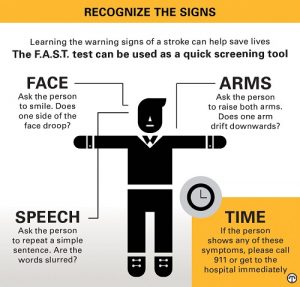 (NAPSI)—Every four minutes in the United States, a stroke victim dies-but knowing the signs and symptoms to watch for can help reduce death from stroke and improve outcomes by getting people appropriate and timely care.
(NAPSI)—Every four minutes in the United States, a stroke victim dies-but knowing the signs and symptoms to watch for can help reduce death from stroke and improve outcomes by getting people appropriate and timely care.
The fifth leading cause of death and the leading cause of serious long-term disability in the United States, stroke affects 800,000 people every year. Unfortunately, many Americans do not recognize the signs of a stroke, so they ignore the symptoms or don’t call 9-1-1. Recognizing the signs and acting immediately could be the difference between making a recovery and living with long-term disability.
What You Should Know
A stroke occurs when a blood vessel that carries blood and oxygen to the brain is blocked by plaque or a blood clot (acute ischemic stroke) or ruptures and bleeds (hemorrhagic stroke). The apparent signs and symptoms of stroke include speech impairment, arm numbness and weakness, severe headache, sudden confusion, trouble seeing out of one or both eyes, as well as uncontrollable drooping of the face.
There are several types of risk factors for stroke, some of which are hereditary while others are preventable by altering one’s lifestyle choices. Some of these risk factors include smoking and the use of tobacco, eating an unhealthy diet, consuming alcohol in excessive amounts, and a lack of daily exercise.
Recognizing and understanding the signs and symptoms of a stroke is crucial. Immediate medical attention may limit the effects of a stroke, so it’s imperative to call 9-1-1 at the first sign.
Always Act F.A.S.T.
If you or someone you know begins to show signs or symptoms of a stroke, there’s a four-letter acronym, “F.A.S.T.,” that corresponds to a test that can be used as a quick screening tool:
- F=FACE, loss of function on one side of your face, which may look like drooping
- A=ARMS, sudden weakness on one side, which may mean you can’t hold the arm up
- S=SPEECH, as in slurred speech
- T=TIME, meaning it’s time to call 9-1-1 right away.
If a person shows any of these symptoms, call 9-1-1 or get to a hospital immediately.
Learn More
For further facts and advice about stroke, visit
www.strokeawareness.com/strokecall911.
Cynthia Lopinto
Latest posts by Cynthia Lopinto (see all)
- Honey Chocolate–Covered Pretzels - April 3, 2018
- True Colors - April 3, 2018
- Spring Cleaning…You’ve Gotta Be Kidding - April 2, 2018
- Should You Stay In Your Home Or Move During Retirement? - April 2, 2018
- Hawaiian Plants For Good Health - April 2, 2018
 Home Front Magazine A Publication for Seniors
Home Front Magazine A Publication for Seniors

